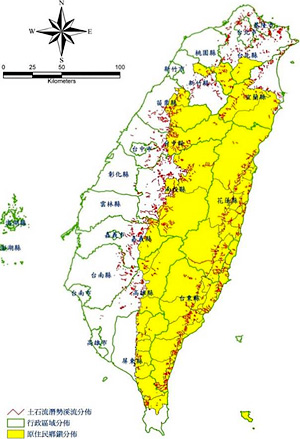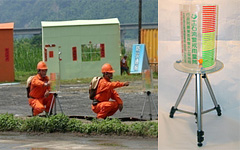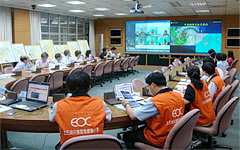About Us
Learning from Taiwan
Volunteers play key role for debris-flows disaster management
"Taiwan-Japan Joint Research Conference on Sabo" was held on 31 January 2013 in Tokyo. Among many presentations I was particularly interested in the one by Mr. Ming-Yao Huang, Director General, Soil and Water Conservation Bureau, Council of Agriculture, Taiwan on "Community debris-flow disaster management in Taiwan".
In Taiwan there are 585 villages at risk of debris-flows (for the year 2013), most of which are in remote mountain areas where rainfall stations are scarce and rescue operation is difficult. (Box1)
Therefore it is a policy of the government to establish a disaster management organization in each village at risk of debris-flows and to assign 2 to 3 volunteers each to such villages. Their main tasks include to monitor rainfalls for early warning (Box2), and to assist in evacuation/rescue operations. Volunteer appointments are renewable every three years. They will be re-appointed through their desire after receiving training again.
For the volunteers to fully accomplish the tasks, government gives a training course in three stages: basic training, advanced training and on-the-job training. Government provides them with a portable rain-gauge, tools for field works and insurance (3,500,000 Taiwan $) for the three years term.
Since the introduction of the volunteers system in April 2005, a total of 3,044 volunteers have been recruited. Currently 1,387 volunteers are assigned to 543 villages covering 94% of the debris-flows prone villages.
Typhoon Morakot in 2009 proved the importance of the role of the volunteers. Thanks to their dedicated works in early warning and rescue operations, human damage was minimized. About 9,100 residents could evacuate timely and the number of the dead/injured could be limited to 1,046 persons despite such a wide spread heavy damage over various sectors.
Taiwan can be said to be one of the most advanced in the world in dealing with debris-flow disasters. While applying advanced technology at the central level (Box 3), Taiwan successfully pursues debris-flow disaster reduction through strengthening disaster management at the local level in that the disaster volunteers are playing a vital role.
Debris-flow disasters are occurring frequently all over the world and will be more in the future as a result of the climate change. Many countries are making effort in different ways to effectively deal with debris-flow disasters. This approach of Taiwan may be a good model for those countries to consider to apply.
Box 1. Distribution of torrents of potential debris-flows

As many as 1,664 torrents (red color small lines) threaten 585 villages.
Box 2. Training on rainfall measurement with a portable rain-gauge

Rainfall warning level has been set for each village. When forecasted rainfall exceeds the warning leve, evacuation is recommended. When actual rainfall exceeds the warning level, evacuation is ordered. Thus the rainfall measurement by volunteers is critical for disaster management operation.
Box 3. National Center for Disaster Management

Disaster management of Taiwan, one of the most advanced in the world, works well in the combination between those at the central level and the local level.
March 2013
Hidetomi Oi
President, International Sabo Association